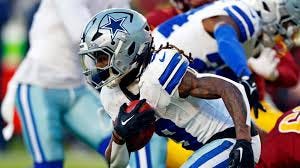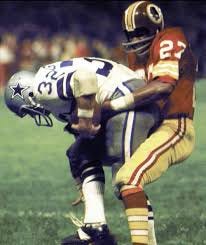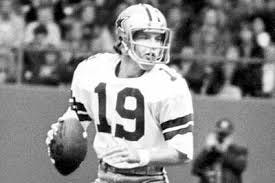Cowboys, Commanders renew the rancor
Dallas' out-of-control win in Washington spruces up the NFL's best rivalry
And, in Game 139, the rivalry returned.
It stubbed its toe and it tripped over a footstool and it ran head first into a chandelier, but it returned, despite all of Daniel Snyder’s attempts to kill it. Washington and Dallas, the magnetic poles of the NFL for so many decades, are back again, intertwined by circumstances and history. The Cowboys won, 34-26, which wasn’t expected, but the game reminded us that perfection is neve the goal when the NFL’s best enemies meet. Pandemonium is.
Surely it was the most bombastic five minutes and 16 seconds of the 2024 season and maybe any other season in memory. Dallas led, 20-9, even though Cooper Rush and not Dak Prescott was quarterbacking. Prescott is 11-2 against Washington, which was sleepwalking for years until Snyder was forced to give up the franchise. The new regime, led by Josh Harris and general manager Adam Peters, took Jayden Daniels with the No. 2 pick in the draft and hired Cowboys’ defensive coordinator Dan Quinn as head coach, and they were 7-4, rebranded and resuscitated, coming in.
Daniels hustled the Commanders to a touchdown, on his 4-yard pass to Zach Ertz, and if they could have forced a punt they had a chance. Instead, KaVontae Turpin of the Cowboys fumbled the punt, reached back to pick it up, went from 0 to 60 in about two yards, did a spin move that left Jeremy Reed flailing at molecules, and did not stop until the end zone. That’s a 99-yard touchdown for the most dangerous returner in the game, and a 27-17 lead.
That was just the preface. With 2:47 left. Daniels tore away from Dallas for 24 yards, hit a couple of passes, and got Washington to the Dallas 33. Knowing he would need a field goal and a touchdown, Quinn ordered a 51-yard try on second down, with 1:44 left, and Austin Seibert nailed it.
So how do you get the ball back for the touchdown you need? Well, you get a sack from Daron Payne that ruins Dallas’ plans to run out the clock. The Cowboys had to punt again, and Daniels got the ball back with 0:33 left. Roger Staubach once wrote a book called Time Enough To Win. It certainly was time to blow a coverage, and Terry McLaurin ran through and past everyone for an 86-yard touchdown that got the Commanders to within 27-26.
The crowd began thinking of overtime. Maybe Tyler Ott, the long snapper on the extra point, did too. His effort was so off-line that holder Tress Way earned a gold star just for catching the ball and getting it down. Seibert missed it anyway.
So here comes the predetermined onside kick. Juanyeah Thomas grabs it for Dallas. Seeing daylight, he runs into the end zone. Coach Mike McCarthy smiles helplessly. Sure, Dallas now leads 34-26 but would have clinched if Thomas had just knelt. Instead, Daniels has a shot at a Hail Mary and a tie. Turns out, he has already spent his lifetime supply of such plays in a win over Chicago. The Cowboys celebrate like it’s Clint Longley and Drew Pearson all over again.
Dallas-Washington is such an Contempt-A-Bowl that the NFL, every time it realigns, makes sure the two are in the same division, in defiance of geography. When it burned the brightest, Washington looked at the Cowboys as a bunch of technocratic, soulless robots programmed by coach Tom Landry, whose outward emotions, to paraphrase Dorothy Parker, ran the gamut from A to B. The Cowboys viewed Washington as a bunch of elderly vulgarians, the Over-The-Hill Gang assembled by rah-rah coach George Allen, who should have filled out an application to occupy the same field.
Dallas played in a futuristic stadium with a hole in the roof, protecting the fans and letting the players deal with the elements. Washington played in D.C. Stadium, later to be known as RFK Stadium, a glorious tenement which threatened to collapse from the noise and the foot-stomping whenever its heroes scored. Only those who were essential to the D.C. political scene and mediasphere were allowed to watch from the box of club president Edward Bennett Williams. On the walk from the Metro station to the stadium gates, the street people sold “Dallas Sucks” buttons that sometimes found the lapels of Congressmen.
The Cowboys owner was Clint Murchison, an invisible oilman who left the stage for general manager Tex Schramm. However, Murchison launched the rivalry before the first football was inflated. Washington owner George Preston Marshall tried to bar Murchison from bringing a Dallas franchise into the NFL because his club, then known as the Redskins, claimed the entire South as its market. Murchison and a friend responded by buying the rights to “Hail To The Redskins,” the club’s theme song. Unless the Cowboys were permitted to exist, he told Marshall, the song won’t be heard in D.C. Marshall capitulated, and the Cowboys became an expansion team in 1960. The only team with whom they could compete was Washington. And vice versa. The Cowboys had also used the expansion draft to take Washington’s former quarterback Eddie LeBaron, a 5-foot-7 Korean war hero who would become Howard Hughes’ lawyer in Las Vegas. LeBaron could do amazing things, and began doing them at the expense of the Redskins.
Marshall was an unapologetic segregationist who said he’d start playing Blacks as soon as the Harlem Globetrotters began employing whites. The Cowboys relied on black players, several from HBCUs, from the beginning. Some of their fans formed the Chicken Club and, in 1961, plotted to release 75 chickens onto the turf in Washington, 74 of which were white. It never got that far, but John F. Kennedy’s administration used the terms of the D.C. Stadium lease as a hammer to make Marshall integrate. Soon Bobby Mitchell and Charlie Taylor were scoring touchdowns in a fashion that Washington fans had only seen from opponents.
The teams got better together. The Cowboys played for NFL championships in 1966 and 1967. Vince Lombardi left Green Bay to coach Washington, but cancer claimed him before he could get much done. It was left to Allen, the first to proclaim “The Future Is Now” and a coach who led his team in “For He’s A Jolly Good Fellow” after wins, to take on the Ice Machine.
Washington throttled the Cowboys, 26-3, in the 1972 NFC Championship Game at RFK. The rest of the decade was spent settling that score or expanding on it. In 1973, safety Ken Houston stopped Dallas’ Walt Garrison, who was an actual rodeo rider, on the one-yard-line and protected Washington’s 14-7 win. The next year, on Thanksgiving Day, the Redskins knocked Roger Staubach out of the game and led 16-3, and Landry turned to Clint Longley, a rookie from Abilene Christian and a noted rattlesnake hunter. Longley fired a 50-yard touchdown to Pearson and the Cowboys won. Staubach remained the starter, of course, and in 1976 Longley sucker-punched Staubach after practice. He was banished to San Diego, which some thought was his goal all along, and the Cowboys got draft choices that they used to get Tony Dorsett. With him, they played in three of the next four Super Bowls, winning one.
Staubach said goodbye to the rivalry in his own signature way. In 1979 the Redskins came to Dallas to decide the division title. Defensive tackle Diron Talbert was confident enough to send a funeral wreath to the Cowboys during the week. Then Washington led 17-0 and 34-21. Staubach triggered two scores in the final five minutes and Dallas won 35-34. Afterward, Harvey Martin took the wreath to the visiting locker room, opened the door and threw it into the team huddle, interrupting a prayer. That was Staubach’s final regular season game.
In ‘82 Washington won the NFC Championship at home over Dallas, leading to the first of three Super Bowl wins with Joe Gibbs coaching. But in their next meeting, Danny White borrowed some Staubach mojo, overcame a 23-3 halftime deficit, and won it for Dallas, 31-30.
In ‘91 Washington began the season 11-0 en route to another Super Bowl title. But the young Cowboys, putting something together with Troy Aikman, Michael Irvin and Emmitt Smith, went to RFK and won, 24-21. Those Cowboys would begin their own triple Super Bowl run the next season.
In ‘06, Washington kicker Nick Novak missed a 49-yard field goal near the end of the game, and Dallas kicker Mike Vanderjagt lined up a 35-yarder. That was blocked by Troy Vincent, now an assistant to commissioner Roger Goodell. Sean Taylor got the ball and was tackled in Dallas territory, and when Kyle Kozier grabbed Taylor’s facemask, Washington got 15 more yards. Novak drilled that field goal to win it.
And in ‘12, the two ended the season with a division-deciding game on a freezing night in Landover, Md. Washington intercepted Tony Romo three times and won, 21-18.
Too many times in between, the teams were unequal or the stakes were minimal. On Sunday, the Cowboys and Commanders played the first game in NFL history with two kickoff returns for touchdowns, a blocked punt and two missed extra points. The residue will be visible the next time they play, in Arlington, Tx. on Jan. 5, and one hopes it will reinforce what Dallas and Washington have always demonstrated. Opposites shouldn’t just attract. They should collide.






The Mad Bomber game was a Thanksgiving stunner from long ago.